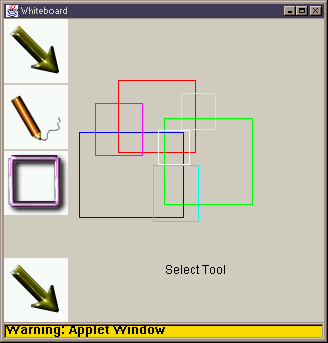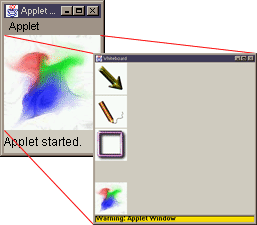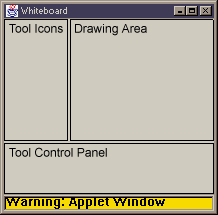
The whiteboard in action |
A whiteboard is a simple drawing utility, commonly
supplied as part of a collaboration framework to allow distributed users
to share a common drawing space. In this article, we will examine how JDK
1.1 simplifies the implementation of such an application.
Lightweight components, introduced by JDK 1.1, offer several important advantages over traditional JDK 1.0-style components. For one, they are much more efficient than traditional components because they do not make use of native GUI peers, being instead a pure-Java kluge on top of the old AWT. More importantly for this particular application, however, is that these components are transparent. This means that a lightweight component can easily overlay information on top of another component.
We will use this transparency feature to implement our whiteboard; when the user selects a particular drawing tool then a lightweight component will be overlaid on the whiteboard. The drawing tool can then use this component to annotate the whiteboard display and collect GUI events.
The whiteboard
Our whiteboard is perforce simple; the constraint of understandability
requires that it be of fairly limited expanse. Hopefully, however, the
techniques I demonstrate will be of fairly broad use, and will allow you
to easily modify the application to suit your own needs.

The whiteboard in action |
The following classes comprise the whiteboard:
Stepping through the classes
For the sake of brevity, I will discuss the classes in general terms
only, allowing you to read the source for a greater understanding.
Class WBLauncher
WBLauncher
is a simple applet that provides a simple introductory interface to the
whiteboard, delaying the download of the whiteboard's classes until the
user chooses to launch it.

The whiteboard launcher |
Because we are using the JDK 1.1 AWT, we must explicitly declare interest in GUI events in order to receive them. For this reason, we call the enableEvents() method in order to receive mouse events:
enableEvents (AWTEvent.MOUSE_EVENT_MASK);These events are delivered through the new method hierarchy to our processEvent() method that can process the event as necessary:
protected void processMouseEvent (MouseEvent e) ...In this next method, we use a Class.forName().newInstance() sequence to create an instance of the whiteboard. Using this mechanism, the whiteboard classes are only downloaded when the user actually clicks on the launcher:
Class theClass = Class.forName ("org.merlin.step.nov.WB");
wb = (Frame) theClass.newInstance ();
To initialize the whiteboard, we pass a dummy ActionEvent to its
dispatchEvent()
method with this as the source of the event; the whiteboard will
then make use of our
Applet methods. In particular, it can call
getCodeBase()
to determine its origin and can then download its configuration and image
files:
wb.dispatchEvent (new ActionEvent (this, AWTEvent.RESERVED_ID_MAX + 1, ""));Class WB

The whiteboard layout |
As a component subclass, we must again call enableEvents() in order to receive events; in this case, window events:
enableEvents (AWTEvent.WINDOW_EVENT_MASK);These window events will be passed to the processWindowEvent() method where we can handle the user closing the window:
protected void processWindowEvent (WindowEvent e) {
super.processWindowEvent (e);
if (e.getID () == WindowEvent.WINDOW_CLOSING)
setVisible (false);
}
To trap the ActionEvent that the WBLauncher passes to
initialize the whiteboard, we must also override the
processEvent()
method:
protected void processEvent (AWTEvent e) {
if ((e instanceof ActionEvent) && (e.getSource () instanceof Applet))
init ((Applet) e.getSource ());
else
super.processEvent (e);
}
When the whiteboard is initialized, it downloads a simple configuration
file. To parse this text file, we use the new Reader classes of
JDK 1.1, which are more efficient, correct, and generalized for reading
text than the InputStream classes. We use the character encoding
"latin1",
which stands for
ISO Latin 1.
URL u = new URL (parent.getCodeBase (), "config.txt"); InputStreamReader i = new InputStreamReader (u.openStream (), "latin1"); BufferedReader r = new BufferedReader (i); String line; while ((line = r.readLine ()) != null) ...The rest of the initialization simply lays out the user interface, which includes a row of tool icons on the left of the frame, a tool control panel at the bottom, and a whiteboard in the remaining space.
Clicking on any of the tool icons passes an ActionEvent to our actionPerformed() method. We then initialize the selected tool, display its control panel, and overlay its display component on the whiteboard, as shown here:
public void actionPerformed (ActionEvent e) ...I'll discuss the whiteboard tools in more detail when we get to the Tool class.
Interface Tool
The Tool
interface describes whiteboard drawing tools, and declares four methods:
setDisplayList,
getDisplay,
getControls, and
dispose. Let's
take a look at each of these methods in more detail.
public void setDisplayList (ObservableList contents);When a tool is initialized, this method is called to supply it with the current whiteboard display list (a list of Elements that make up the whiteboard drawing). The tool can manipulate the whiteboard by manipulating the elements of the display list.
public Component getDisplay ();The getDisplay method returns a Component, which is overlaid on the actual whiteboard. The drawing tool can use this display surface to provide overlaid information (for example, partially drawn display elements) and to collect user-interface events, such as the user clicking on the whiteboard or dragging out a rectangle.
public Component getControls ();The getControls method returns a Component or Container of control tools to configure the tool. The Component/Container is displayed at the bottom of the whiteboard.
public void dispose ();We call dispose when another whiteboard tool is selected.
Two example tools, Rect and Select, are detailed later on.
Interface Element
The Element
interface describes each drawing element in the whiteboard. Different Elements
are typically created and added to the whiteboard by the various drawing
tools.
For the purposes of networking, all drawing elements must be serializable; for this reason, we extend the Serializable interface:
public interface Element extends java.io.Serializable ...Our whiteboard is fairly simple and provides only three methods in this interface: getBounds, paint, and getTranslated.
public Rectangle getBounds ();The getBounds method returns a Rectangle describing the bounding box of the element.
public void paint (Graphics g);The paint method is called when the element should draw itself to the specified graphics context, g.
public Element getTranslated (int dX, int dY);Lastly, getTranslated returns a duplicate of the element, translated by the specified offset, which moves elements of the whiteboard.
Class WBContainer
The WBContainer
class is a lightweight container that displays the current contents of
the whiteboard. When a drawing tool is active, its transparent display
Component
is overlaid on this container.
When it is created, the WBContainer registers to be notified whenever the whiteboard display list is altered:
displayList.addUpdateListener (this);Whenever an update occurs, we simply call repaint():
public void updateOccurred (UpdateEvent e) {
repaint ();
}
The paint() method loops through the display list, calling each
Element's
paint() method. We use the bounding box of each element and the
graphics clipping rectangle to make the repainting as efficient as possible.
Class Rect
Rect is a
very simple whiteboard tool that allows the user to draw rectangles of
various colors. It is actually composed of two classes: Rect (the
actual tool), which implements the Tool interface, the transparent
lightweight overlay component and the control panel; and RectElement,
which is a rectangle
Element.
We'll begin with the methods of the Tool interface:
Writing the Rect tool is then simply a case of writing an AWT component; integration into the whiteboard is transparent.
Finally, once a completed RectElement is added to the display list, we're done. The WBContainer will be automatically notified of the change and will repaint itself appropriately.
Class Select
The Select
tool is even simpler than the Rect tool, being just one class
that implements the Tool interface.
Select processes
events in the normal manner, manipulating the display list using the simple
methods that provide and move
Elements with their getTranslated()
methods.
Again, it is essentially a standalone AWT component that manipulates a list of Elements; it has no particular knowledge of the whiteboard into which it is integrated, as changes to the display list are automatically reflected by the WBContainer.
Class ObservableList
The ObservableList
class is an observable Vector. Interested listeners register through
the addUpdateListener() and
removeUpdateListener() methods.
Whenever an update is made to the list, the listeners will be notified.
For the time being, this class is implemented simply with an internal Vector. Next month, we will examine various mechanisms for networking the whiteboard with this class.
Interface UpdateListener
The UpdateListener
interface is the mechanism by which listeners are notified of updates to
an ObservableList.
public void updateOccurred (UpdateEvent e);We call updateOccurred when an update is made to the list.
Class UpdateEvent
UpdateEvent
notifies listeners when ObservableList has been updated. The event
currently contains no payload of interest; a more involved implementation
could indicate the particular change that occurred.
Class LWContainer
LWContainer
is a simple minimal lightweight container; we simply extend
Container
and provide no additional methods. If
Container were not abstract,
this approach would be equivalent to using instances of the Container
class itself.
LWContainer is much more efficient for layout purposes than the traditional Panel class. Because the class is pure Java, it does not require a corresponding native peer GUI component.
Class LWImageButton
LWImageButton
is a simple lightweight image button: When the mouse moves over the image
button, we highlight it; when the mouse button is pressed, we depress the
image button; and when the mouse button is released, we fire an ActionEvent.
Because graphical Java buttons have been discussed in detail over the past few years (far too many times!), and because the transition to the JDK 1.1 event model follows the form that we have discussed in the past few episodes of Step by Step, I will not bore you with a dissection of the methods I used. (See the Resources section for links to discussions on this topic.)
Conclusion
As seems to be my standard operating procedure, I have flown through
a fairly large project in leaps and bounds; however, the main ideas are
simple:
Let me provide an example of the benefit of this design. To accommodate multiple views of the whiteboard, all we have to do is create another WBContainer somewhere else, tied to the same display list. No changes would be required to any of our existing code.
This approach is simply good object-oriented design. By applying these techniques in your own applications, you will be able to easily extend and enhance them, with minimal changes to existing code.
Next month, we'll look at networking the code to enable distributed
users access to the same drawing space.![]()